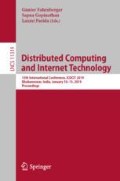Abstract
In social networks, a network grows by following certain rules and patterns, e.g. a collaboration network in which authors come together and publish an article. These authors might have collaborated previously, or they may collaborate in the future with other authors. That is how a collaboration network grows. Collaboration networks are represented as graphs where nodes denote authors and edges between nodes indicate a collaboration between the corresponding authors. There are very few network formation models specific to collaboration networks in the literature. In this work, a novel network formation model that can imitate the growth of a collaboration network is proposed. The main idea is based on the arrival distribution of the numbers of authors collaborating for the papers. We find that Exponential distribution matches best for this process simulation. We have used DBLP dataset to analyze and find the patterns in the network. We show that the network generated by the proposed model is closer to the original network than that of Shi et al. The model has to be further refined in order to improve the results for average clustering coefficient and density of the network.
Access this chapter
Tax calculation will be finalised at checkout
Purchases are for personal use only
References
DBLP: Computer science bibliography. https://dblp.uni-trier.de
Barabasi, A.L., Jeong, H., Neda, Z., Ravasz, E., Schubert, A., Vicsek, T.: Evolution of the social network of scientific collaborations. Physica A: Statist. Mech. Appl. 311, 590–614 (2002). https://doi.org/10.1016/S0378-4371(02)00736-7
Barabasi, A.L., Albert, R.: Emergence of scaling in random networks. Science 286, 509–512 (1999)
Bishop, C.M.: Pattern Recognition and Machine Learning. Springer, Heidelberg (2006). https://doi.org/10.1007/978-1-4615-7566-5
Schreiber, F., Junker, B.H.: Analysis of Biological Networks. Wiley, Hoboken (2007)
Kullback, S., Leibler, R.: On information and sufficiency. Ann. Math. Statist. 22(1), 79–86 (1951)
Lakshmi, T.J., Bhavani, S.D.: Temporal probabilistic measure for link prediction in collaborative networks. Appl. Intell. 47(1), 83–95 (2017)
Leskovec, J., Kleinberg, J., Faloutsos, C.: Graphs over time: densification laws, shrinking diameters and possible explanations. In: 11th International Conference on Knowledge Discovery and Data mining, pp. 177–187 (2005)
Liben-Nowell, D., Kleinberg, J.: The link-prediction problem for social networks. J. Am. Soc. Inf. Sci. Technol. 58(7), 1019–1031 (2007)
Middendorf, M., Ziv, E., Wiggins, C.H.: Inferring network mechanisms: the Drosophila melanogaster protein interaction network. Proc. Natl. Acad. Sci. 102, 3192–3197 (2005)
Milo, R., Kashtan, N., Itzkovitz, S., Newman, M.E.J., Alon, U.: On the uniform generation of random graphs with prescribed degree sequences. arXiv e-prints (2003)
Newman, M.E.J.: Scientific collaboration networks. i. Network construction and fundamental results. Phys. Rev. E Stat. Nonlin. Soft Matter Phys. (2001). https://doi.org/10.1103/PhysRevE.64.016131
Newman, M.E.J.: The structure of scientific collaboration networks. Proc. Natl. Acad. Sci. 98, 404–409 (2001)
Newman, M.E.J.: Networks: An Introduction. Oxford University Press, Oxford (2010)
Navlakha, S., Kingsford, C.: Network archaeology: uncovering ancient networks from present-day interactions. PLoS Comput. Biol. 7(4), e1001119 (2011)
Shi, X., Wu, L., Yang, H.: Scientific collaboration network evolution model based on motif emerging. In: The 9th International Conference for Young Computer Scientists, pp. 2748–2752 (2008)
Author information
Authors and Affiliations
Corresponding authors
Editor information
Editors and Affiliations
Rights and permissions
Copyright information
© 2019 Springer Nature Switzerland AG
About this paper
Cite this paper
Sharma, A., Bhavani, S.D. (2019). A Network Formation Model for Collaboration Networks. In: Fahrnberger, G., Gopinathan, S., Parida, L. (eds) Distributed Computing and Internet Technology. ICDCIT 2019. Lecture Notes in Computer Science(), vol 11319. Springer, Cham. https://doi.org/10.1007/978-3-030-05366-6_24
Download citation
DOI: https://doi.org/10.1007/978-3-030-05366-6_24
Published:
Publisher Name: Springer, Cham
Print ISBN: 978-3-030-05365-9
Online ISBN: 978-3-030-05366-6
eBook Packages: Computer ScienceComputer Science (R0)

